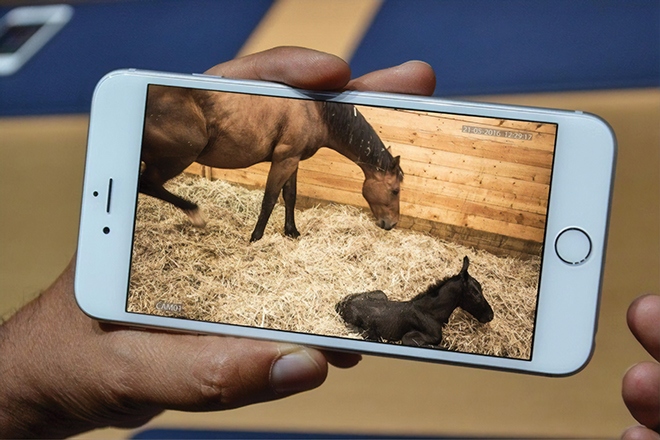
One of cinema’s most popular comedies, “Meet the Parents,” features a scene where Jack (Robert DeNiro) is showing Greg (Ben Stiller) his new invention – a camera hidden inside an everyday household item. The first “nanny cam” was invented in 1992 and it allowed parents to secretly monitor their kids and hired babysitters.
What started as a discrete method for keeping an eye on children and caretakers has become wildly popular for safeguarding against theft, watching pets play at doggy day care and seeing foals scamper on wobbly legs. Camera systems catch more than the playful antics of a breeder’s newest arrivals. They allow breeders to monitor a mare’s progress from the comfort of the house.
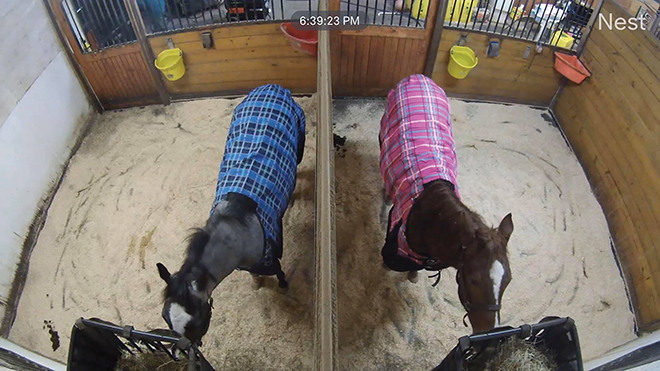
“I have no interest in my mares pulling a fast one on me when foaling is imminent,” said Emma Walker of Caldwell, Texas. “I have a five-camera set up. Four of them are used to cover stalls and the fifth one looks out at a small pasture so I can see them even when outside.”
Capturing a horse resting, working or playing in a paddock offers an added level of reassurance for trainers responsible for client-owned horses. Blake Britton, a Chillicothe, Ohio trainer, installed a 12-camera hard-wired system that cost around $500. He placed the cameras throughout the stall area, the indoor arena, a covered round pen and pastures.
“We had a horse hurt in a freak longing accident. With the cameras, we could zoom in and see exactly what happened,” he said. “Accidents happen and as trainers we don’t always take the business steps through an LLC to protect ourselves, cameras can help.”
Josh Faulkner, the head trainer at Leavell Farms in Simpsonville, Kentucky, adds that cameras in the arena gives clients an opportunity to check in on the progress of their horse. On occasion, he’s invited a customer to watch a training session, given them a passcode and allowed them to watch the ride.
“The barn had a hard-wired system when I got here, but we’ve recently replaced it with Yi wireless cameras,” he said. “I’m not all that technical and they were fairly easy to set up. It took about 10 minutes per camera to hang, sync and plug in.”
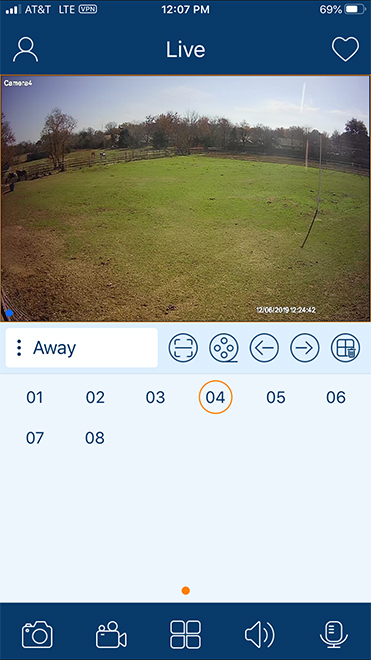
Theft is another reason horse folks install surveillance cameras. The United States Department of Justice estimates a burglary occurs somewhere in the country every 18 seconds. Britton remembers his family’s barn was burglarized when he was a child. Thieves took everything.
“We were wiped clean,” he said. “So, I put one camera in our saddling area that’s facing the tack stall so we can watch there, one on the main entrance, one that looks down the driveway and in every aisle way.”
It’s no secret that not all help is reliable. Video security systems also give trainers the tools to confirm chores are being done correctly and timely. Trainers who travel often rely on the help to feed, clean stalls and monitor the horses without direct supervision.
“Right now, we’re lucky to have great help,” Britton said. “When we’ve had unreliable help in the past the cameras gave us comfort that we could see what was going on at home when we were traveling.”
A quick online search for security camera systems returns an endless list of results. Prices range from a few hundred to a few thousand dollars. Some are hard wired, others run on Wi-Fi. With so many choices, selecting the right system can be overwhelming.
We asked several trainers and breeders to share their advice and lessons learned.
Baby Watch
Baby monitors have long been parents’ go to for keeping an extra “eye” on infants. The original models offered only audio, but today video too has crept into the nursery – and foaling stalls. Walker recently upgraded from a FunLux system to the Arlo Pro 2. She installed the cameras herself and the project took less than an hour. Through an upgrade, she wanted a camera with a wider view, night vision and HD video. The Arlo Pro 2 offered those features.
“Having the ability to two-way talk is huge,” she said. “If there is an emergency and you are birthing that baby out alone someone can easily sign on and talk you through it.”
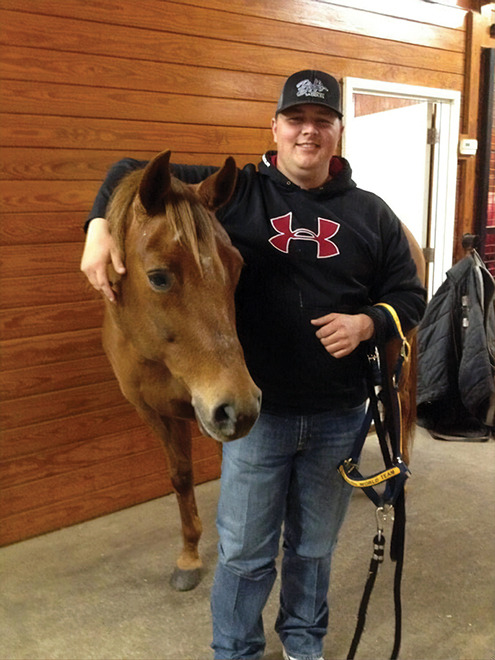
Laurie Kuchler, owner of Little Shadow Farm in Sunbury, Ohio opted for the Nest, a system widely known for its “smart” thermostats. Among Kuchler’s favorite features are night vision, carbon monoxide and smoke detection and 10 days of video storage with NestAware. When she needs extra help during foaling season, she can share a link and have a helper watch from a remote location.
“If your barn is further away from your home you’ll need a Wi-Fi extender or you’ll have to have the cable company install a router in your barn. We are about 100 feet away so we don’t experience any problems,” she said.
At Dream Quarter Horses in Calhoun, Louisiana, breeder Teresa Porter uses a Moonbaby system. She estimates it cost about $200. The cameras rotate and the monitor has a split screen, which covers both foaling stalls.
“I chose it because it does not require Wi-Fi and I could put the monitor in my camper to keep an eye on them at night,” she said. “The signal is strong enough it picks up through the metal walls and over 50-100 feet away.”
Something most people don’t realize when purchasing these cameras is that many have maximum and minimum temperature ranges. This may not be a major issue in warmer climates but is important for barns in colder places to consider.
“I think mine is from 115F to –4F,” Walker said. “This is not a major issue here in Texas, but I imagine it could be in the northern half of the country.”
Placement is another important consideration, according to Walker. She recommends placing cameras in an accessible place.
“I can’t tell you how many times I have opened my phone to check on mares and, boom, spider web on the camera,” she said. “Make sure it is relatively easy to access the camera location to keep the lens free and clear of debris.”
At home or on the go
Trainers and exhibitors have had costly equipment stolen. In 2018, $200,000 worth of tack was stolen at the Henry County Saddle Club in Newcastle, Indiana. This wasn’t the first case, it’s happened at the Reichert Celebration and the Denver Stock Show. These likely won’t be the last show burglaries. Lara Yungclas has used StallWatch, a portable video surveillance system for extra security. Plus, it allowed her to keep an eye on horses that are prone to colic.
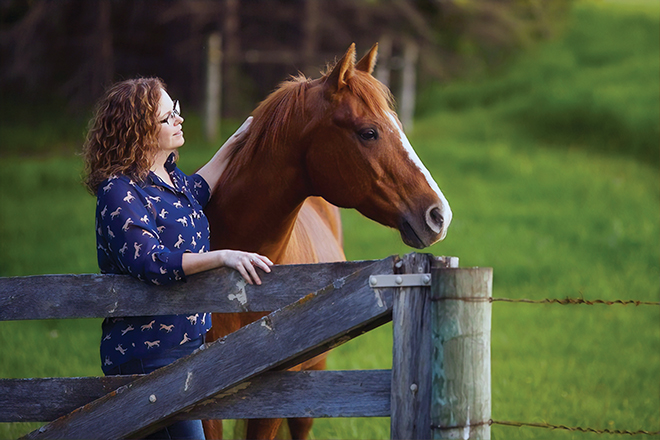
“As long as there was cell service they worked well,” she said. “The system has a Wi-Fi service included as part of the rental fee.”
For about $200 a month she rented four cameras that she could move between home and shows. The challenge was that not all stabling areas had good cell service. Without that, the system didn’t work.
“A mobile unit like that came in handy more often than I thought it would,” she said. “It’s a great investment for keeping your eye on sick horses, your valuable equipment and your employees. I feel like it paid for itself in the long run and keeping employees honest.”
Whitesboro, Texas trainer Tate Oakley has also used stall cameras at shows. He started using them when the concept was new to the industry. He liked being able to see his stall area around the clock and having the opportunity to review recorded video if something occurred overnight. The system also offered the flexibility of being set up at home, a benefit he appreciated when traveling for long periods of time.
“Know the long-term costs as far as a contract and do research on the cameras to make sure they are what you want,” he suggested.
No experience necessary
Installing video surveillance systems once seemed like an overwhelming process that required a professional. With systems like Arlo, Nest and others, experience isn’t necessary. Porter says she knows nothing about cameras and electronics.
“I am technically challenged as I like to say. This system was super easy for me to set up,” she said.
Britton says it took he and his father-in-law a half day to hardwire in the 12 cameras. They started with a wireless system. Inconsistent service made the cameras unreliable so he removed them and replaced them with a hardwired system. The initial system included eight cameras and cost around $500. He purchased four additional cameras.
“Our cameras are Samsung. They are made for residential areas, not horse barns so the cords that come with them aren’t long enough,” he said. “We went on Amazon, found longer cords and couplers and spent a couple hundred dollars there.”
Breeder Cassie Moore chose to work with Riverwind Surveillance Supply rather than select and install a system on her own. The owner guided her through the process of selecting the right camera set up for her operation and walked her through set up via phone call and is available for ongoing IT support.
“As a horse owner, you have to determine what your needs are,” she said. “My system has a DVR so I can go back and look through the system or view live. The only thing I wish mine had is better night vision.”
Peace of mind
Professional photographer Shelley Paulson describes herself as a technophile and thought it would be fun to be able to set up a camera system to be able to keep an eye on the horses. Having cameras has given her peace of mind, especially when traveling on photoshoots for long periods of time. As an added bonus, they save her extra trips out to the barn in inclement weather.
“Our winters can get very cold in Minnesota and we have frequent snow storms, so having cameras allows me to check that they are eating and drinking without having to go out in the elements,” she said.
She shares her expert installation tips based on pan/tilt/zoom (PTZ) Amcrest cameras she installed in the lean-tos and the barn. Her short YouTube video offers step-by-step advice. https://youtu.be/7Wt9Xl3Sbwc



You must be logged in to post a comment Login